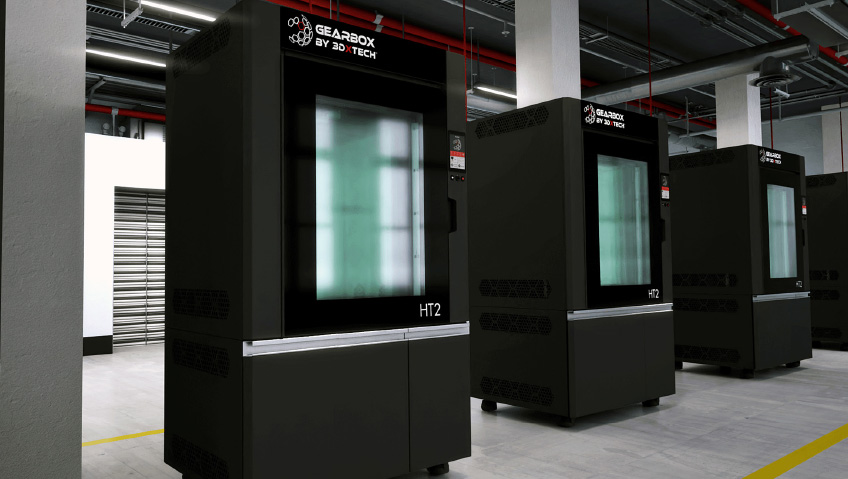The story of 3DXTECH began when, after thirty years of working for global leaders in the high-performance plastics and composites industry, the emerging technology of three-dimensional (3D) printing caught Matt Howlett’s eye. He bought a 3D printer, quickly recognized the untapped potential, and launched 3DXTECH in 2014.
Because he came from a high-performance background, Howlett was able to immediately recognize the gap in the market. “All the materials that I could see were largely general-purpose,” he remembers. “There was nothing really interesting out there from a materials aspect. So I started 3DXTECH with the entire purpose of introducing higher-performance materials to the market than were currently available.”
The company quickly earned an enviable reputation for its use of high-temperature polymers and carbon fiber. “3DXTECH is known for high-performance materials and cutting-edge technology,” Howlett says, and the team works hard to remain at the leading edge of the industry, consistently coming out “with something new and different,” to meet the ever-evolving needs of a market hungry for next-level solutions.
“We started creating a lot of really interesting materials to be printed,” he remembers. The effort paid off almost immediately. “Before I knew it, we were regularly selling to companies like SpaceX, Lockheed Martin, Northrop Grumman, BAE Systems—across the board, you name it.” Even NASA was interested. “Nobody was really fulfilling the need in the market for high-performance materials.”
Supplying this high-performance material turned out to be just the first step. “That inevitably led to the question of ‘Which printer do you recommend for this material?’ And we would recommend printer X or printer Y just because it had decent capabilities, but it really wasn’t ideal for our type of high-performance materials.”
This need drove the company to take the next step in its journey of firsts. “In 2018, we decided to create our own printer because we really needed an answer to that question, ‘Which printer do you recommend for these high-performance materials?’”
3DXTECH started by hiring a team of several dozen engineers. They got to work and developed the Gearbox™ HT2 3D printer, which launched at the end of 2021. “The first customers were, no surprise, aerospace clients who had been pushing us for years to make this machine. We finally had the answer to the question of, ‘Which printer do you recommend for your high-performance materials?’ That’s really the crux of why we did this.”
This journey has been unique within the industry. “We’re the first materials company that invested in a 3D printer to integrate the materials into the printer,” Howlett says. “Typically, what happens is a company will make a printer and then try to find materials that work well in it, whereas, we started from the opposite perspective, a materials-first perspective.”
“We have a materials-first strategy, and we’ll build the materials that the customers need and that the printer will then be able to handle, as opposed to the other way around. It’s kind of a solution looking for a problem if you don’t do it that way. I really can’t think of another printer company that we compete with that was a materials company first and then created a printer to fill in the gaps.”
The company’s products continue to be a hit, attracting everyone from “consumers running low-cost machines, all the way through to NASA and Lockheed Martin.” The aerospace industry has been particularly interested because the industry demands “high-performance materials and needs a printer that is really ideally suited for high-performance materials.” 3DXTECH has also done very well with the energy industry because “this printer can print materials that are ideally situated for oil and gas applications.”
3DXTECH has a democracy-only sourcing policy with 90 percent of the printer coming from U.S.-based suppliers and the remaining from those in Germany, Taiwan, and Japan. Howlett explains that, “We could likely source parts much less expensively in non-democratic countries, but that’s not who we are and not what we want to support—and our aerospace / defense customers are always pushing for U.S.-sourced and U.S.-made.”
The printers themselves are made in the U.S.A, almost exclusively within the company’s home base of Michigan. “Eighty percent of the printer is made within one hundred miles of Grand Rapids,” Howlett reports.
“Our team members pride themselves on delivering difficult orders. A big company will get a hold of us and say, ‘We need something special,’ and so we do it. We make special materials for many of these [customers]. Many of these specialty materials have even made it into space.”
For example, one high profile customer “needed tungsten-filled PEKK (a thermoplastic also known as polyetherketoneketone) for an application that’s going into space that had a very specific neutron shielding capability, and they went to many of the big-name players—legacy companies in the business—and they all told them no, and we made the material for them in two months.”
This quality is made possible by a team of experts who have worked in the field for decades. “We have engineers on staff that have anywhere from twenty to forty years of experience in the industry,” Howlett says. “So we have quite a depth of materials engineering know-how.”
The company culture encourages collaboration and communication, ensuring that employees all work together for the best outcome. “Everyone feels like they are on the team, and they understand what the goals are and that they are all working toward them,” Howlett says. “I’ve never been surrounded by such a great team of engineers and salespeople and front office. This is the best team that I’ve ever worked with in my thirty years.”
The team is specially trained to ensure they can deliver the support customers need, and if they do not know the solution, they will bring in someone who can help. “Each one of our salespeople, each one of our tech service people, each one of our customer service people is trained to be able to answer technical questions and then bring that issue up the chain if they don’t have the knowledge to be able to answer it.”
This training is important due to the complexity of the subject matter. Customers “have a lot of questions that we need to be able to provide a lot of answers for,” as subject matter experts, Howlett says. “We can help disseminate that information in an effective way to them so that they can be successful in what they’re trying to do.”
The journey that humbly began in Matt Howlett’s basement has quickly progressed. Teaming up with Howlett’s long-time colleague in the plastics industry, Gary Foote, the company already owns its building in Grand Rapids, Michigan, occupying the structure’s entire 68,000 square feet. “We’ve been growing at about a fifty percent-plus growth rate year-over-year, and we’re in the multi-millions,” he says.
In October 2021, while retaining his role as president and CEO, Howlett and his business partner Gary Foote sold 3DXTECH to Chicago-based private equity firm CORE Industrial Partners, which focuses on 4th generation manufacturers. “We took the company as far as we could on our own and needed a partner who could help us grow the business to the next level. CORE has significant investments in other additive manufacturing companies and their experience and resources were an ideal fit for us.”
Since closing, the benefits of working with CORE have been very clear. “That’s really given us the ability to grow beyond what we could have done on our own. We have access to expertise and capital that have significantly propelled our growth just in the short time we’ve been with CORE… We have access to capital but also access to their partner companies to increase our vendor base.”
But that is not all. “They want to grow our business with acquisitions,” Howlett adds. “So with CORE’s assistance, we’ve been evaluating multiple companies both here in the U.S. and abroad to add them to our portfolio.”
Armed with leading-edge high-performance materials, a specially designed printer, and the support of a private equity firm, 3DTECH is all set to continue blazing a trail through the 3D printing industry.






